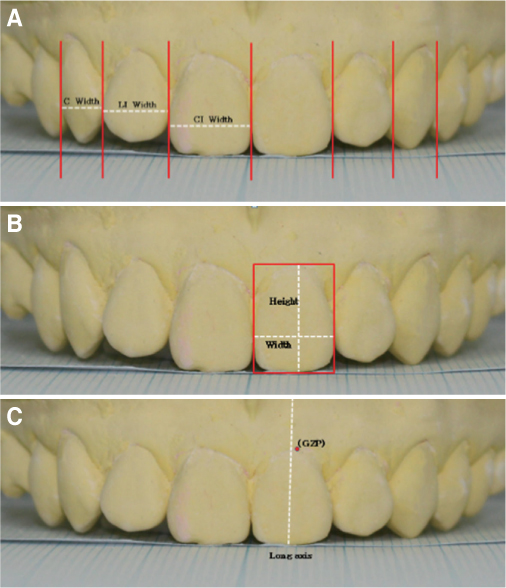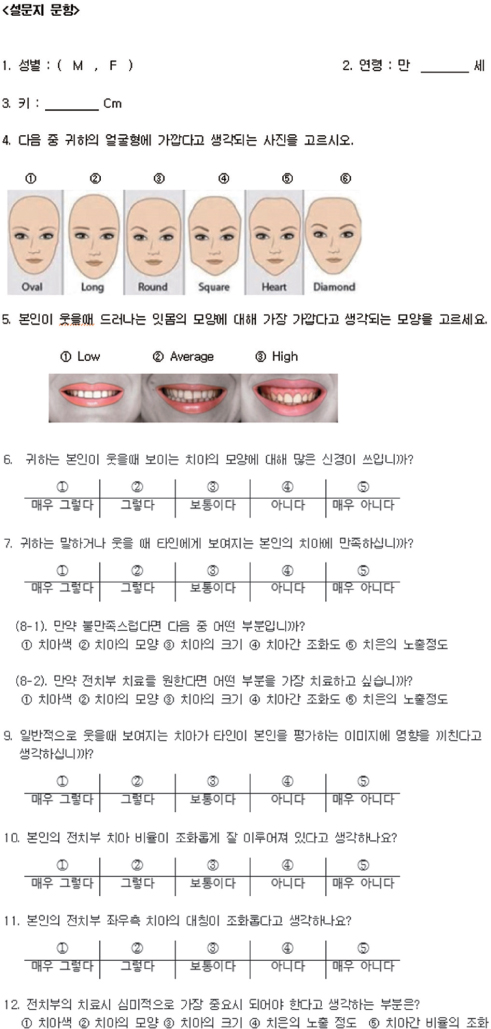J Korean Acad Prosthodont.
2019 Apr;57(2):118-126. 10.4047/jkap.2019.57.2.118.
Analysis of esthetic factors and evaluation of esthetic perception for maxillary anteriors of dental students
- Affiliations
-
- 1School of Dentistry, Chonnam National University, Gwngju, Republic of Korea.
- 2Department of Periodontology, School of Dentistry, Dental Science Research Institute, Chonnam National University, Gwangju, Republic of Korea. periodrk@chonnam.ac.kr
- KMID: 2444180
- DOI: http://doi.org/10.4047/jkap.2019.57.2.118
Abstract
- PURPOSE
This research is to investigate factors that affect dental aesthetics and analyze whether individual perception affects and difference of genders affects the esthetic factors.
MATERIALS AND METHODS
Seventy dental students of Chonnam University aged from 25 to 35 years old without periodontal problems were included. Maxillary dental cast for participants were made, and standardized photo was taken with a digital camera. Maximum visual width and the position of gingival zenith of maxillary anterior teeth and maximum height of the maxillary central incisors were measured by a measurement program and the shape of central incisor was categorized. Questionnaire was conducted to evaluate esthetic perception. SPSS program was used to perform statistical analysis.
RESULTS
The average visual width ratio of right maxillary anteriors was 1.38:1:0.78 and 1.41:1:0.81 for the left which differ from the golden ratio. The width to height ratio for right and left central incisor was 0.84 and 0.83 respectively. The gingival zenith position was determined to be: mostly, central incisors and canines were located in the distal side, lateral incisors were located in the center. The visual width ratio of right maxillary anterior teeth, ratio of width to height of central incisor, gingival zenith position, crown morphology and amounts of gingival exposure upon smiling were not significantly different between genders, and facial patterns and these dental esthetic factors were not related to aesthetic perception.
CONCLUSION
Even though participants had the visual width ratio of maxillary anteriors or ideal width to ideal height of central incisors that did not agree with the golden ratio, they had high satisfaction for dental esthetics. Esthetic perception depends more on subjective judgements of participants than objective indices.
Figure
Cited by 1 articles
-
The effect of utilizing augmented reality in a mobile application for sequential tooth carving by users
Jae-Gi Lee, Jung-Hee Bae
J Dent Rehabil Appl Sci. 2023;39(2):69-78. doi: 10.14368/jdras.2023.39.2.69.
Reference
-
1. Moskowitz ME, Nayyar A. Determinants of dental esthetics: a rational for smile analysis and treatment. Compend Contin Educ Dent. 1995; 16:1164. 1166.2. Levin EI. Dental esthetics and the golden proportion. J Prosthet Dent. 1978; 40:244–252.
Article3. Brisman AS. Esthetics: a comparison of dentists' and patients' concepts. J Am Dent Assoc. 1980; 100:345–352.
Article4. Cooper GE, Tredwin CJ, Cooper NT, Petrie A, Gill DS. The influence of maxillary central incisor height-to-width ratio on perceived smile aesthetics. Br Dent J. 2012; 212:589–599.
Article5. Mattos CM, Santana RB. A quantitative evaluation of the spatial displacement of the gingival zenith in the maxillary anterior dentition. J Periodontol. 2008; 79:1880–1885.
Article6. Wheeler RC. Complete crown form and the periodontium. J Prosthet Dent. 1961; 11:722–734.
Article7. Ahmad I. Geometric considerations in anterior dental aesthetics: restorative principles. Pract Periodontics Aesthet Dent. 1998; 10:813–822.8. Hall WR. Shapes and sizes of teeth from American system of dentistry. Philadelphia: Lea Bros;1987. p. 981.9. Heravi F, Rashed R, Abachizadeh H. Esthetic preferences for the shape of anterior teeth in a posed smile. Am J Orthod Dentofacial Orthop. 2011; 139:806–814.
Article10. Lombardi RE. The principles of visual perception and their clinical application to denture esthetics. J Prosthet Dent. 1973; 29:358–382.
Article11. Preston JD. The golden proportion revisited. J Esthet Dent. 1993; 5:247–251.
Article12. Mahshid M, Khoshvaghti A, Varshosaz M, Vallaei N. Evaluation of “golden proportion” in individuals with an esthetic smile. J Esthet Restor Dent. 2004; 16:185–192.
Article13. Sarver DM. Principles of cosmetic dentistry in orthodontics: Part 1. Shape and proportionality of anterior teeth. Am J Orthod Dentofacial Orthop. 2004; 126:749–753.
Article14. Gürel G. The science and art of porcelain laminate veneers. Chicago: Quintessence;2004. p. 67–75.15. Morr T. Understanding the esthetic evaluation for success. J Calif Dent Assoc. 2004; 32:153–160.16. Chu SJ, Tan JH, Stappert CF, Tarnow DP. Gingival zenith positions and levels of the maxillary anterior dentition. J Esthet Restor Dent. 2009; 21:113–120.
Article17. Ong E, Brown RA, Richmond S. Peer assessment of dental attractiveness. Am J Orthod Dentofacial Orthop. 2006; 130:163–169.
Article18. Anderson KM, Behrents RG, McKinney T, Buschang PH. Tooth shape preferences in an esthetic smile. Am J Orthod Dentofacial Orthop. 2005; 128:458–465.
Article19. Matthews TG. The anatomy of a smile. J Prosthet Dent. 1978; 39:128–134.
Article20. Chiche GJ, Pinault A. Smile rejuvenation: a methodic approach. Pract Periodontics Aesthet Dent. 1993; 5:37–44.21. Ahmad I. Anterior dental aesthetics: facial perspective. Br Dent J. 2005; 199:15–21.
Article22. Shin S, Noh KT, Kwon KR, Kim HS. Use of digital smile design in esthetic restoration in anterior teeth: A case report. J Korean Acad Prosthodont. 2017; 55:164–170.
Article
- Full Text Links
- Actions
-
Cited
- CITED
-
- Close
- Share
- Similar articles
-
- Esthetic evaluation of maxillary single-tooth implants in the esthetic zone
- Esthetic improvement in the patient with one missing maxillary central incisor restored with porcelain laminate veneers
- Implant esthetic restoration with bone graft in the extended maxillary anterior area: A case report
- Esthetic outcome for maxillary anterior single implants assessed by different dental specialists
- Esthetic restoration using Digital Smile Design: a case report



